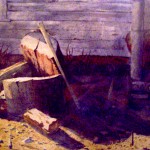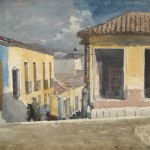
The question many watercolor artist have when faced with depicting the tangle of shapes and colors they see is: “How am I going to portray this in my painting?” They may be looking over a field of vegetation with dappled sunlight reflecting off of every leaf or blade of grass. No one could paint it all, and only few would attempt to do so. The secret is to paint the illusion of whatever your subject is in reality, and then finish the painting with detail in well-planned places; mostly, in the foreground. The eye will interpret the abstract based on a few specifically defined areas. The challenge is creating the texture that represents that which the eye imagine it sees.
If you experiment with textural techniques, it probably will not turn out the way you imagined it, but it very likely might turn out to be a pleasant surprise and much better than you imagined it. My only advise is to use the techniques with well planned moderation. Be creative, but remember, over use of the techniques can make texture itself the center of interest.
Listed below are just a few popular textural techniques watercolorists use, they really are as numerous as one’s imagination:

- Throwing paint (flinging it onto the painting with a loaded brush).
- Pouring or dripping paint onto the substrate.
- Squirting it on with a squirt bottle.
- Manipulating it with a paint knife.
- Manipulating it with a roller.
- Allowing the colors to combine and mix themselves wet in wet.
- Sprinkling salt on it while still wet.
- Sprinkling water on paint while it is still wet to manipulate direction.
- Preserving planned whites with masking, or without masking.
- Using fingers or fists to manipulate paint.
- Fine splattering (not to be confused with flinging or throwing).
- Stamps.
- Stencils.
- Sponges.
- Crimped paper.
- Cling wrap.
- Scraping.
Having a conversation about the use of each of these technique is a blog post in itself, much too long for this one. Art Center Information will be discussing them in subsequent blogs.
